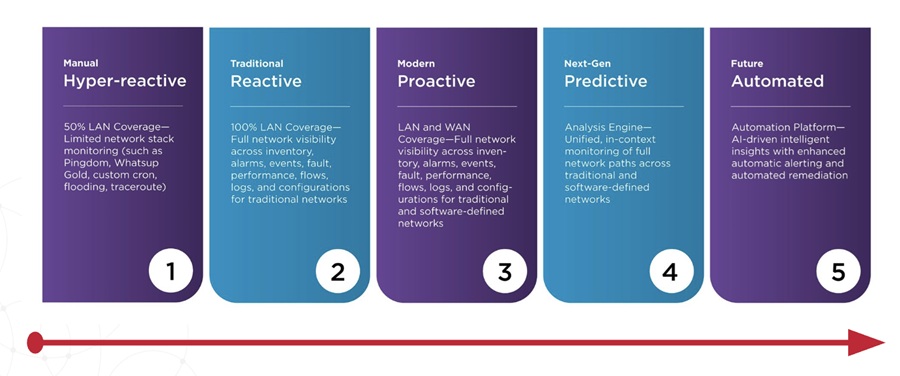

If you’ve followed my recent articles for APMdigest — on why you need application-aware network performance management (AA-NPM) tools a few weeks ago and, more recently, on why you need to integrate IT operations management and service management — perhaps you’ve already guessed where I’m heading. The more effectively we can integrate management tools at every level and the more effectively we can manage the delivery of IT as a service to our constituents, the more value we add to the enterprise and its mission.
At the same time, the further we enlarge those circles to encompass and integrate infrastructures that were previously disconnected, the greater the number of elements we need to incorporate, monitor and manage. It’s not just servers and storage systems — it’s everything from switches and routers to firewall appliances, to passive devices like printers, power and cooling systems, and more. It’s the mouse and the keyboard attached to each PC in the business; it’s the cell phone and the tablet that walked in — BYOD! — with an employee just this morning.
And we haven’t even touched on software or actual business processes.
I don’t think I need to go on; you know how complex and chaotic the broader infrastructure can become. We need something that ties all these disparate pieces together, a focal point that connects all these different physical and virtual assets and that fundamentally understands how all the different pieces of the IT puzzle fit together.
That’s where the configuration management database (CMDB) fits in. It’s not simply one more tool on par with every other tool in the world of IT management — that CMDB is dead! In today’s demanding environment, CMDB is the beating heart of a dynamic IT infrastructure, the element that connects all the assets involved in the delivery of everything from business services to the end-user experience. It must be understood as such — and deployed as such — for IT to deliver the higher levels of service it strives to deliver.
The Single Source of Truth
During the Gartner I&O summit last summer, an IT director from a large insurance company said to me, “We have so many tools doing multiple jobs in managing the IT infrastructure that I have lost the idea of a single version of truth.”
It’s easy to understand how this gentleman could say this: IT in a large company involves thousands — if not millions — of assets and processes interacting at once. If only small portions of that broader IT infrastructure are integrated then it is impossible to gain access to a single source of truth. There are simply too many barriers that stand in the way.
With a properly built and fully populated CMDB, though, those barriers begin to fall down. Not only would such a CMDB recognize all the IT and non-IT assets, all the processes and all the SLAs within the enterprise, it would recognize the relationships between these assets, processes and more. Put another way, if you looked up a physical asset in the CMDB as I’m describing it, not only would you learn about its physical characteristics — who manufactured it and when, what’s inside of it, how it’s licensed and more — you would also learn what role it plays in the delivery of any business service that touches it. You could see what flags it raised as well as when and where it exceeded or missed performance marks identified by the QoS levels and SLAs attached to services.
Moreover, you would see how that asset is connected to other assets within both the enterprise and the service delivery environment — and begin to understand how a change in the performance of one asset ripples through to other assets to affect the performance of an entire service. That level of visibility and insight is required for you to achieve real, effective change management in your organization.
In short, a CMDB that is properly designed and fully populated with information about the assets, processes, relationships and dependencies can be the single source of information from which actionable insights can arise about the state of the broad service delivery environment. And with that information, you can respond appropriately to deliver the best possible service to your clients.
Not There … Yet
So, one has to ask: If a CMDB is this great, why are we still having problems integrating these complex service delivery infrastructures? The simple answer is that few CMDB implementations are mature enough to provide the right balance of integration, support, ease of deployment, and cost-justification.
Many CMDB offerings are still vendor-specific, so they will only discover the assets that have been built by (or are supported by) a given vendor. Other CMDB implementations are more vendor-neutral but lack the tools to discover all the different types of assets that may be in use in a given environment. They may be able to detect a wide range of servers and network appliances, for example, but perhaps they cannot see the power and cooling systems installed in the server racks themselves. Still others require a prohibitive investment of time to configure and populate. Many are hugely expensive to acquire and maintain.
But this will change. Vendors may need to be pushed, but as IT organizations set higher expectations of vendor CMDB offerings — because they understand the critical role that a CMDB can play in integrating all aspects of a well-managed service delivery environment — then vendor offerings will evolve to overcome the issues described above. You should expect — even demand — more than you can get today: more integration, more federation, more robust relationship mapping between assets, better tools for visualizing actionable information, more extensive reporting and more insightful dashboards.
As for the integrated AA-NPM tools and integrated operational and service management tools that we talked about at the beginning of this series? They will integrate with the CMDB to provide even greater insights into activities, trends and anomalies in the service delivery network. With these deep connections into the CMDB itself, you will be able to use these tools to deliver the highest levels of service both to end users and the clients whose applications you support.
ABOUT Suvish Viswanathan
Suvish Viswanathan is the senior analyst, Unified IT, at ManageEngine, a division of Zoho Corp.


